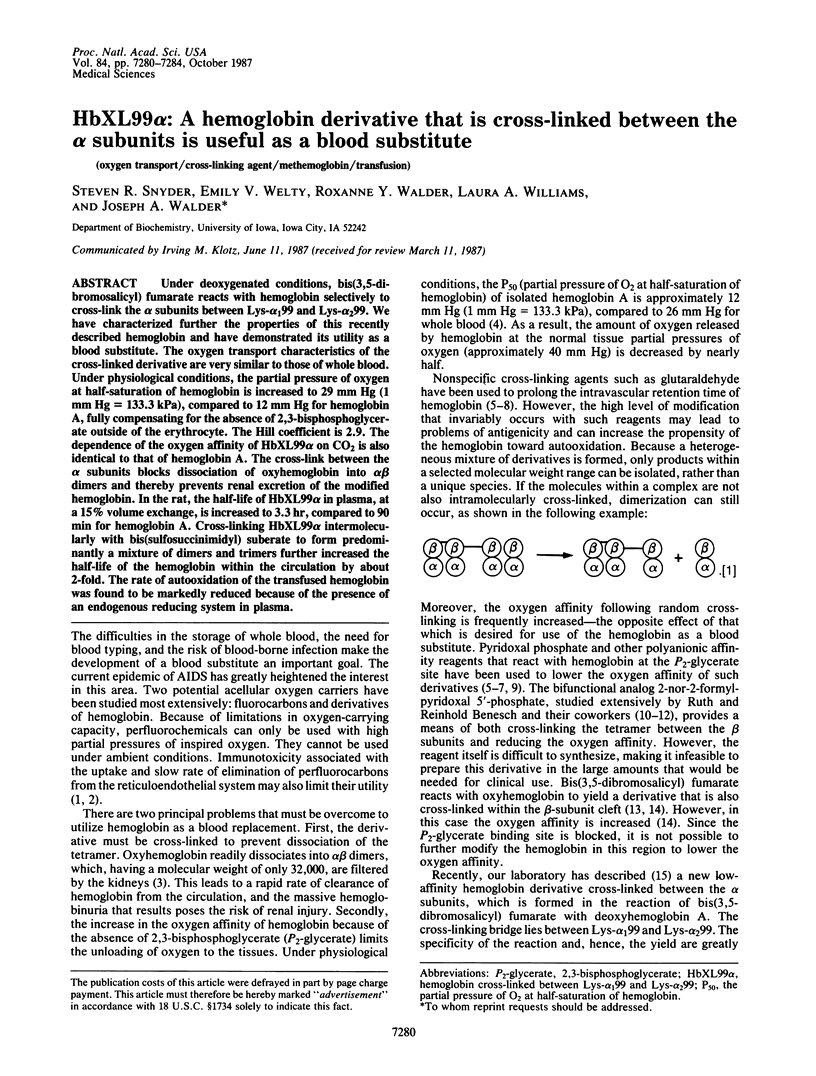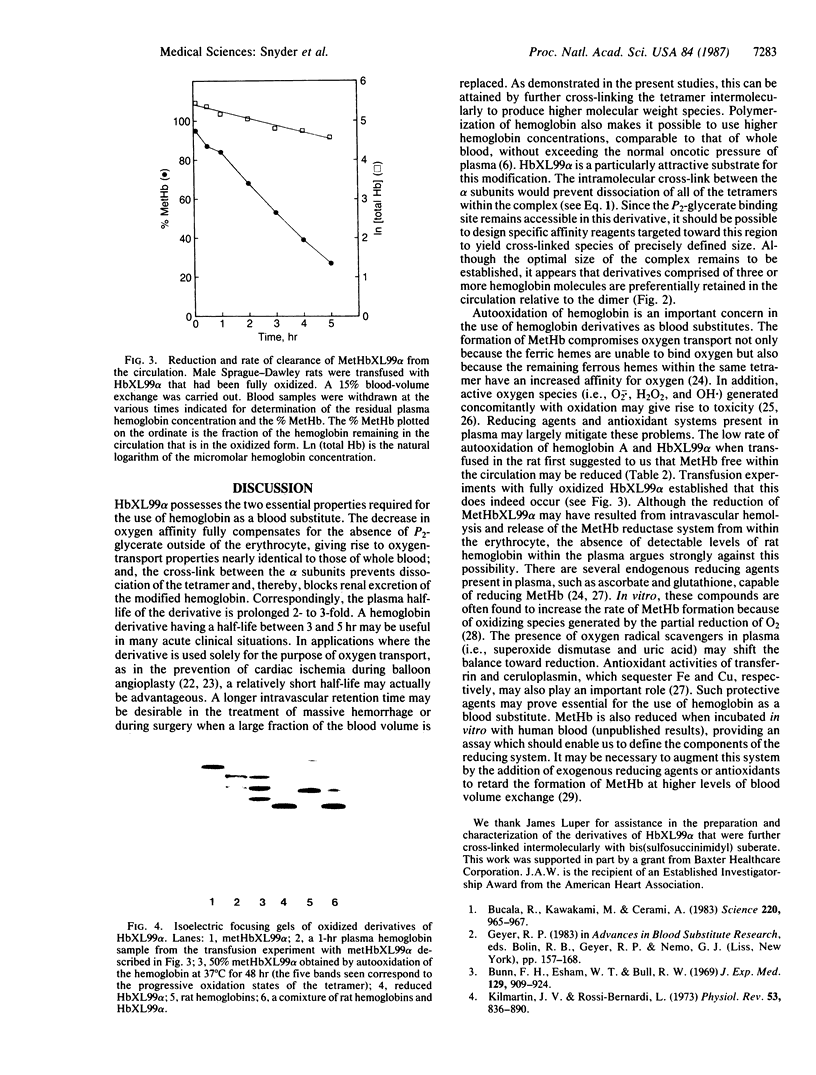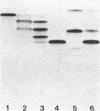Abstract
Under deoxygenated conditions, bis(3,5-dibromosalicyl) fumarate reacts with hemoglobin selectively to cross-link the alpha subunits between Lys-alpha 1 99 and Lys-alpha 2 99. We have characterized further the properties of this recently described hemoglobin and have demonstrated its utility as a blood substitute. The oxygen transport characteristics of the cross-linked derivative are very similar to those of whole blood. Under physiological conditions, the partial pressure of oxygen at half-saturation of hemoglobin is increased to 29 mm Hg (1 mm Hg = 133.3 kPa), compared to 12 mm Hg for hemoglobin A, fully compensating for the absence of 2,3-bisphosphoglycerate outside of the erythrocyte. The Hill coefficient is 2.9. The dependence of the oxygen affinity of HbXL99 alpha on CO2 is also identical to that of hemoglobin A. The cross-link between the alpha subunits blocks dissociation of oxyhemoglobin into alpha beta dimers and thereby prevents renal excretion of the modified hemoglobin. In the rat, the half-life of HbXL99 alpha in plasma, at a 15% volume exchange, is increased to 3.3 hr, compared to 90 min for hemoglobin A. Cross-linking HbXL99 alpha intermolecularly with bis(sulfosuccinimidyl) suberate to form predominantly a mixture of dimers and trimers further increased the half-life of the hemoglobin within the circulation by about 2-fold. The rate of autooxidation of the transfused hemoglobin was found to be markedly reduced because of the presence of an endogenous reducing system in plasma.
Full text
PDF




Images in this article
Selected References
These references are in PubMed. This may not be the complete list of references from this article.
- Anderson H. V., Leimgruber P. P., Roubin G. S., Nelson D. L., Gruentzig A. R. Distal coronary artery perfusion during percutaneous transluminal coronary angioplasty. Am Heart J. 1985 Oct;110(4):720–726. doi: 10.1016/0002-8703(85)90448-x. [DOI] [PubMed] [Google Scholar]
- Arnone A., Benesch R. E., Benesch R. Structure of human deoxyhemoglobin specifically modified with pyridoxal compounds. J Mol Biol. 1977 Oct 5;115(4):627–642. doi: 10.1016/0022-2836(77)90107-3. [DOI] [PubMed] [Google Scholar]
- Benesch R. E., Yung S., Suzuki T., Bauer C., Benesch R. Pyridoxal compounds as specific reagents for the alpha and beta N-termini of hemoglobin. Proc Natl Acad Sci U S A. 1973 Sep;70(9):2595–2599. doi: 10.1073/pnas.70.9.2595. [DOI] [PMC free article] [PubMed] [Google Scholar]
- Benesch R., Benesch R. E., Yung S., Edalji R. Hemoglobin covalently bridged across the polyphoshate binding site. Biochem Biophys Res Commun. 1975 Apr 21;63(4):1123–1129. doi: 10.1016/0006-291x(75)90685-3. [DOI] [PubMed] [Google Scholar]
- Benesch R., Triner L., Benesch R. E., Kwong S., Verosky M. Enhanced oxygen unloading by an interdimerically crosslinked hemoglobin in an isolated perfused rabbit heart. Proc Natl Acad Sci U S A. 1984 May;81(9):2941–2943. doi: 10.1073/pnas.81.9.2941. [DOI] [PMC free article] [PubMed] [Google Scholar]
- Bunn H. F., Esham W. T., Bull R. W. The renal handling of hemoglobin. I. Glomerular filtration. J Exp Med. 1969 May 1;129(5):909–923. doi: 10.1084/jem.129.5.909. [DOI] [PMC free article] [PubMed] [Google Scholar]
- CROSBY W. H., FURTH F. W. A modification of the benzidine method for measurement of hemoglobin in plasma and urine. Blood. 1956 Apr;11(4):380–383. [PubMed] [Google Scholar]
- Chalvardjian A., Rudnicki E. Determination of lipid phosphorus in the nanomolar range. Anal Biochem. 1970 Jul;36(1):225–226. doi: 10.1016/0003-2697(70)90352-0. [DOI] [PubMed] [Google Scholar]
- Chatterjee R., Welty E. V., Walder R. Y., Pruitt S. L., Rogers P. H., Arnone A., Walder J. A. Isolation and characterization of a new hemoglobin derivative cross-linked between the alpha chains (lysine 99 alpha 1----lysine 99 alpha 2). J Biol Chem. 1986 Jul 25;261(21):9929–9937. [PubMed] [Google Scholar]
- Cleman M., Jaffee C. C., Wohlgelernter D. Prevention of ischemia during percutaneous transluminal coronary angioplasty by transcatheter infusion of oxygenated Fluosol DA 20%. Circulation. 1986 Sep;74(3):555–562. doi: 10.1161/01.cir.74.3.555. [DOI] [PubMed] [Google Scholar]
- DeVenuto F., Zegna A. Preparation and evaluation of pyridoxalated-polymerized human hemoglobin. J Surg Res. 1983 Mar;34(3):205–212. doi: 10.1016/0022-4804(83)90061-6. [DOI] [PubMed] [Google Scholar]
- Feola M., Gonzalez H., Canizaro P. C., Bingham D., Periman P. Development of a bovine stroma-free hemoglobin solution as a blood substitute. Surg Gynecol Obstet. 1983 Nov;157(5):399–408. [PubMed] [Google Scholar]
- Fronticelli C., Sato T., Orth C., Bucci E. Bovine hemoglobin as a potential source of hemoglobin-based oxygen carriers: crosslinking with bis(2,3-dibromosalycyl)fumarate. Biochim Biophys Acta. 1986 Nov 7;874(1):76–81. doi: 10.1016/0167-4838(86)90104-4. [DOI] [PubMed] [Google Scholar]
- Kawanishi S., Caughey W. S. Mechanism of electron transfer to coordinated dioxygen of oxyhemoglobins to yield peroxide and methemoglobin. Protein control of electron donation by aquopentacyanoferrate(II). J Biol Chem. 1985 Apr 25;260(8):4622–4631. [PubMed] [Google Scholar]
- Keipert P. E., Chang T. M. Pyridoxylated polyhemoglobin as a red cell substitute for resuscitation of lethal hemorrhagic shock in conscious rats. Biomater Med Devices Artif Organs. 1985;13(1-2):1–15. doi: 10.3109/10731198509118839. [DOI] [PubMed] [Google Scholar]
- Kilmartin J. V., Rossi-Bernardi L. Interaction of hemoglobin with hydrogen ions, carbon dioxide, and organic phosphates. Physiol Rev. 1973 Oct;53(4):836–890. doi: 10.1152/physrev.1973.53.4.836. [DOI] [PubMed] [Google Scholar]
- Misra H. P., Fridovich I. The generation of superoxide radical during the autoxidation of hemoglobin. J Biol Chem. 1972 Nov 10;247(21):6960–6962. [PubMed] [Google Scholar]
- Sadrzadeh S. M., Graf E., Panter S. S., Hallaway P. E., Eaton J. W. Hemoglobin. A biologic fenton reagent. J Biol Chem. 1984 Dec 10;259(23):14354–14356. [PubMed] [Google Scholar]
- Sehgal L. R., Gould S. A., Rosen A. L., Sehgal H. L., Moss G. S. Polymerized pyridoxylated hemoglobin: a red cell substitute with normal oxygen capacity. Surgery. 1984 Apr;95(4):433–438. [PubMed] [Google Scholar]
- Sehgal L. R., Sehgal H. L., Rosen A. L., Gould S. A., Rice C. L., Moss G. S. Control of methemoglobin formation in stroma-free hemoglobin solutions. J Surg Res. 1981 Jul;31(1):13–17. doi: 10.1016/0022-4804(81)90024-x. [DOI] [PubMed] [Google Scholar]
- WANG L. Plasma volume, cell volume, total blood volume and F cells factor in the normal and splenectomized Sherman rat. Am J Physiol. 1959 Jan;196(1):188–192. doi: 10.1152/ajplegacy.1958.196.1.188. [DOI] [PubMed] [Google Scholar]
- Walder J. A., Walder R. Y., Arnone A. Development of antisickling compounds that chemically modify hemoglobin S specifically within the 2,3-diphosphoglycerate binding site. J Mol Biol. 1980 Aug 5;141(2):195–216. doi: 10.1016/0022-2836(80)90385-x. [DOI] [PubMed] [Google Scholar]
- Walder J. A., Zaugg R. H., Walder R. Y., Steele J. M., Klotz I. M. Diaspirins that cross-link beta chains of hemoglobin: bis(3,5-dibromosalicyl) succinate and bis(3,5-dibromosalicyl) fumarate. Biochemistry. 1979 Oct 2;18(20):4265–4270. doi: 10.1021/bi00587a001. [DOI] [PubMed] [Google Scholar]
- van Assendelft O. W., Zijlstra W. G. Extinction coefficients for use in equations for the spectrophotometric analysis of haemoglobin mixtures. Anal Biochem. 1975 Nov;69(1):43–48. doi: 10.1016/0003-2697(75)90563-1. [DOI] [PubMed] [Google Scholar]



